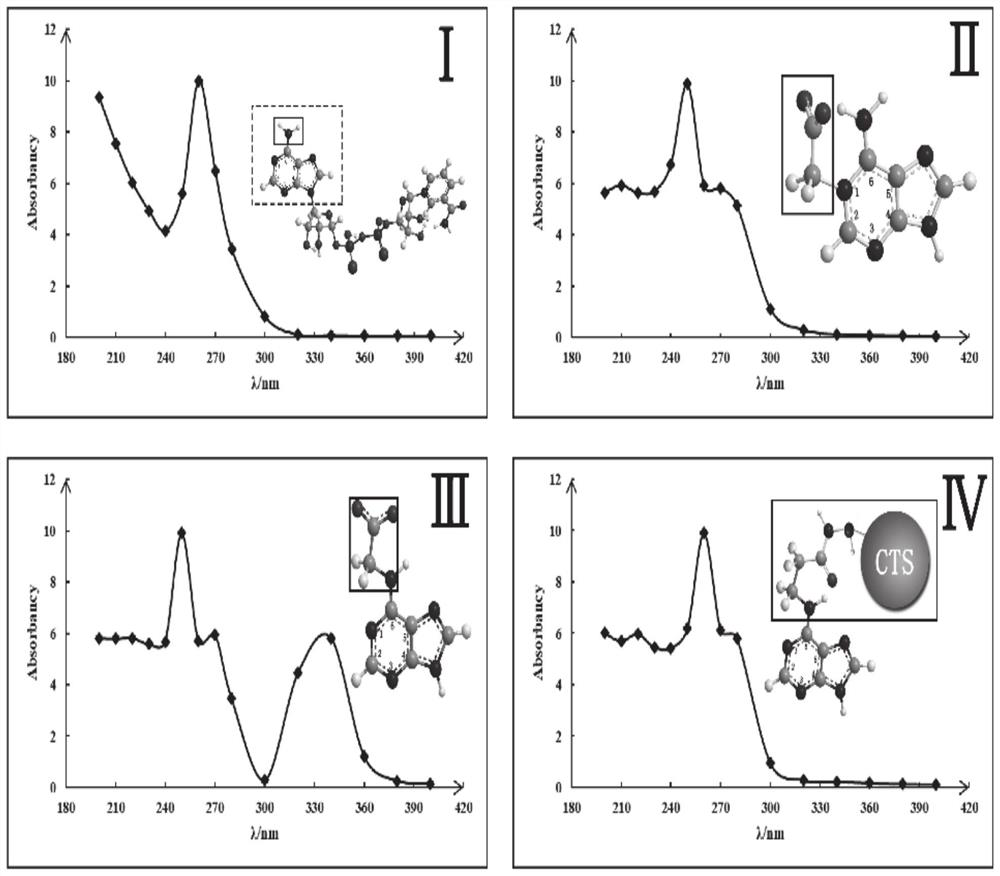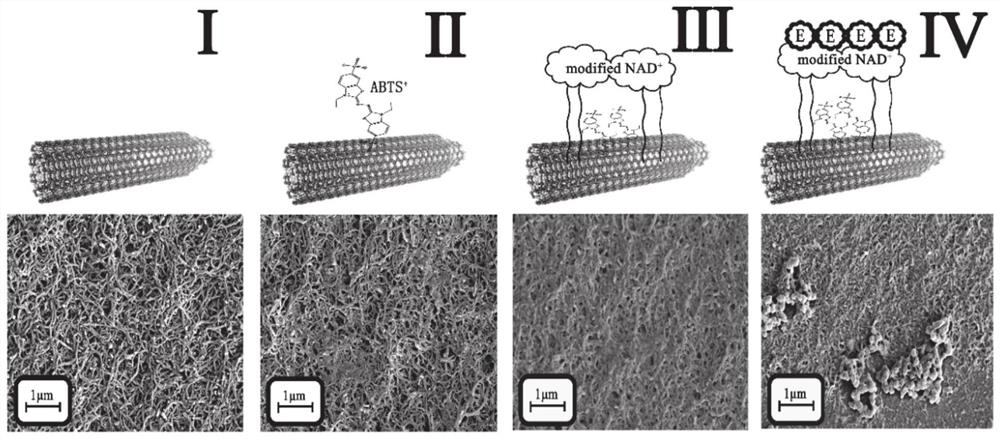Malate dehydrogenase electrode as well as preparation method and application thereof
A malate dehydrogenase and electrode technology, applied in the field of detection and analysis, can solve the problems of slow electron transfer rate, difficult regeneration, unsatisfactory kinetic characteristics, etc.
- Summary
- Abstract
- Description
- Claims
- Application Information
AI Technical Summary
Problems solved by technology
Method used
Image
Examples
Embodiment 1
[0175] Embodiment 1 Chitosan-NAD + Preparation of complex
[0176] Take NAD + Add 1 mL of iodoacetic acid (1 mg / mL) to 5 mL (1 mg / mL) of the aqueous solution, and react in a water bath at 70 °C for 1 h. In the above NAD + Add 1 mL (1.3 mM) of sodium thiosulfate solution to the aqueous solution, adjust the pH to 11 with 1 M NaOH, and react in a water bath at 70°C for 1 h. After that, 1 mL of formaldehyde was added to react in a 70°C water bath for 1 h. Use 1M HCl to adjust the pH of the reaction system to be neutral, add NHS (10mg), EDC (10mg), add 0.1% chitosan solution 10mL [chitosan is medium viscosity chitosan (200-400mPa.s)], React in a water bath at 70°C for 1h. Carry out UV absorption full-wavelength scanning test for key steps.
[0177] Chitosan-NAD + The UV absorption wavelength results during the preparation of the composite are as follows figure 1 As shown, we mainly use NAD + Covalent linkage with chitosan with good water solubility and good film-forming pr...
Embodiment 2
[0177] Chitosan-NAD + The UV absorption wavelength results during the preparation of the composite are as follows figure 1 As shown, we mainly use NAD + Covalent linkage with chitosan with good water solubility and good film-forming properties to realize NAD + Immobilized. NAD + Starting with NAD + It exhibits the largest UV absorption peak at 260nm ( figure 1 -I). Firstly, under acidic environment, iodoacetic acid was used as alkylating agent for NAD + Alkylation of the 1-position nitrogen atom of adenine to give N1-carboxymethyl-NAD + . with NAD + Compared to N1-carboxymethyl-NAD + There is a blue-shifted peak, showing the maximum UV absorption peak at 250nm ( figure 1 -II). Using sodium thiosulfate as reducing agent for N1-carboxymethyl-NAD + Reduction is carried out to obtain N1-carboxymethyl-NADH which is more stable under alkaline conditions. Then carry out Dimroth rearrangement under the condition of strong base to obtain the C6-carboxymethyl NADH whose am...
Embodiment 3
[0191] Embodiment 3 The preparation method of glucose dehydrogenase electrode
[0192] (1) Preparation of glucose dehydrogenase electrode
[0193] All electrochemical measurements were performed in a typical three-electrode system (CHI 760D, CH Instruments). The composition of the three-electrode system includes: a platinum electrode as a counter electrode, an Ag / AgCl electrode as a reference electrode, and a glassy carbon electrode as a working electrode. During the experiment, the glassy carbon electrode with a diameter of 3mm was sequentially filled with Al with a certain particle size 2 o 3 The slurry was polished to a mirror surface on a polishing cloth. After each polishing, the surface dirt was washed off first, and then moved into an ultrasonic water bath for cleaning, each time for 1 min, and repeated three times. Finally, 1:1 ethanol, 1:1 NHO 3 Ultrasonic cleaning. After thorough washing, in 0.20mol / L KNO 3 Medium record 1×10 -3 mol / L K 3 Fe(CN) 6 The cyclic ...
PUM
| Property | Measurement | Unit |
|---|---|---|
| viscosity | aaaaa | aaaaa |
Abstract
Description
Claims
Application Information
 Login to View More
Login to View More - R&D
- Intellectual Property
- Life Sciences
- Materials
- Tech Scout
- Unparalleled Data Quality
- Higher Quality Content
- 60% Fewer Hallucinations
Browse by: Latest US Patents, China's latest patents, Technical Efficacy Thesaurus, Application Domain, Technology Topic, Popular Technical Reports.
© 2025 PatSnap. All rights reserved.Legal|Privacy policy|Modern Slavery Act Transparency Statement|Sitemap|About US| Contact US: help@patsnap.com



